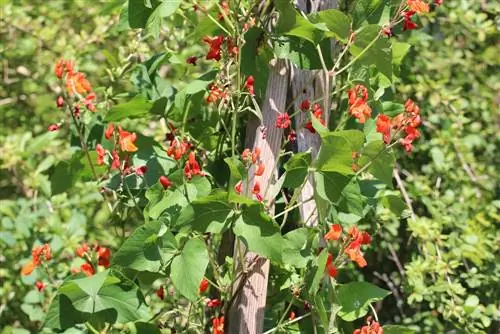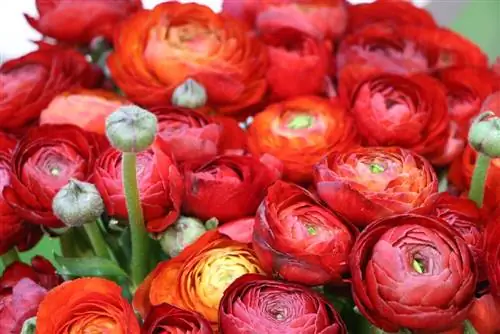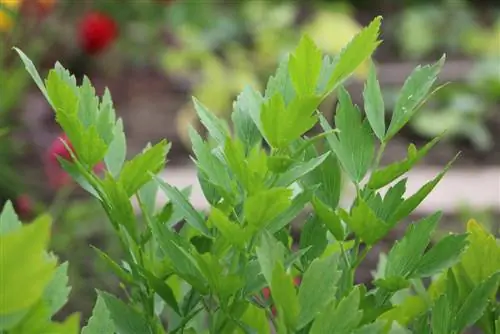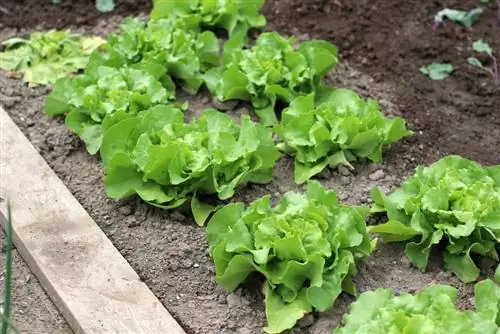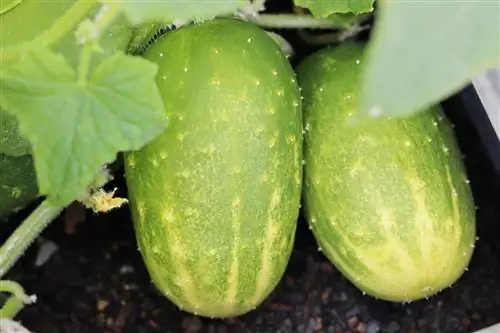- Author admin [email protected].
- Public 2023-12-17 03:39.
- Last modified 2025-01-24 12:45.
The runner bean, also known as the runner bean, originally comes from Central America and is a staple food there. This distinctively colored bean has also been cultivated in Europe since the 17th century. The runner bean is mostly grown for consumption, but with its beautiful flowers it is also very popular as an ornamental plant.
Sowing
There are different varieties of runner beans; White Giant, Hestia, Lady Di and Butler, to name a few. They differ greatly in flower color, height, texture of the beans (some even have threadless pods available) and when they are harvested. Depending on your preferences, a specific variety can be selected.
The runner bean originally comes from a warmer climate, so it is advisable to initially grow the runner beans indoors. The soil should have a temperature of at least 10 degrees, otherwise the seeds will not germinate or will germinate only poorly. Although runner beans are more robust than their relatives such as bush or runner beans, they benefit from growing in the warm room and the harvest yields can be increased through he althy and strong plants.
Before sowing indoors, which can take place from the end of April, the bean seeds can be soaked in water for one to two days, which makes germination easier. The beans are then placed in the potting soil. It is important that the seeds are not sown too deep, around 2-3cm, they should not be more than that - a saying goes: “The beans want to hear the bells ring”. You shouldn't water too much, the seedlings don't like waterlogging. Depending on how warm the seeds are, it takes approx.4-12 days until the first green shoots emerge from the soil.
After the last night frosts have passed, around mid-May, the seeds can be planted directly outside in the ground without preferring them. The early seedlings can also be planted at this time, piling up the stems well to give the plants additional support. Since runner beans are only planted late in the year, it is important to consider whether the bed should be stocked with pre-crops such as lettuce or radishes before the beans are planted.
Fiuge beans need climbing aids, sticks, ropes, arches or even fences can be used, the main thing is that the plants can climb up them. Thanks to the pretty orange-red flowers, the runner bean can also be grown as an ornamental plant on the balcony or as a privacy screen.
Cultivation & Sowing
4-6 plants are used on each trellis; A sunny, wind-protected location should be chosen. Runner beans grow well in calcareous to neutral soil; the plants grow up to three meters high. Since they are so-called weak feeders, they can bind the nitrogen they need for growth from the air using nodule bacteria on their roots. A loose soil without waterlogging is therefore very important for cultivation, otherwise the plants cannot develop properly.
Since the beans produce a high nitrogen content in the soil, you should wait five years until beans or other legumes, e.g. B. Peas can be grown. Good neighbors for runner beans in the garden are lettuce, marigolds or marigolds and various types of cabbage. Peas, onion plants and fennel should not be in the immediate vicinity.
Fieron beans are sown directly outdoors from mid-May to mid-June. To speed up germination, the seeds can be placed in water for one to two days beforehand so that they can absorb the necessary water. Then they are placed in the ground, covered with just a little soil and pressed down a little. Depending on whether it is a weak or strong growing variety, different distances between the seeds must be maintained. After the seed has germinated and a small plant has grown from it, it should be piled up with a little soil all around.
Particularly during germination, but also during the growing season, the runner bean needs sufficient water and loose soil where it gets lots of sun. The runner bean begins to bloom from June onwards and the beans develop, which are best harvested young because otherwise they become hard. Their flowering period can last until September and the harvest season begins in August for most varieties. We cultivate the runner bean as an annual plant and therefore sow it anew every year, but in warmer regions it can also be perennial.
Since the runner beans accumulate nitrogen in the soil, they also play a major role in crop rotation. In this way, after the soil has been depleted by heavy and medium feeders, they can thrive and at the same time regenerate the soil for a new crop rotation with heavy or medium feeders.
The bean has deep roots, so when growing in the field you should pay attention to loose soil and when growing on the balcony to a sufficient depth of the container.
Care
When the bean plants get their first flowers, they must be watered regularly, otherwise the flowers will be dropped and the harvest will be lost. Occasional fertilization with e.g. nettle manure can increase the crop yield. In order to achieve a long harvest period, the beans should be harvested regularly, only then will the plant continue to produce many new flowers.
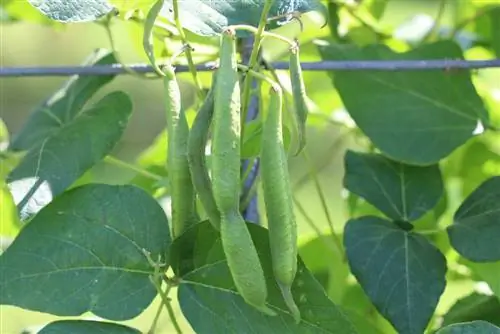
Some varieties of runner bean grow very strongly, form tendrils that can be several meters long and therefore need climbing aid. A grid that is placed in the vegetable bed can be used for this, but poles or cords are also sufficient. The best way to achieve the necessary stability with poles is to set them up like a tent. This plant can also be used to decorate a fence, the wall of a house or a gazebo, where it looks very decorative because of its flowers and also offers good privacy.
Pests
You should check regularly for pest infestation. Young plants in particular are often eaten by snails; appropriate protective measures must be taken here. In the germination phase, the bean fly is particularly important to watch out for; the maggots bore into the seedling and destroy it; the cotyledons die off. Regular watering prevents this pest. Later, on the larger plants, black bean aphids may appear. These can be combated with well-known home remedies such as nettle manure or beneficial insects. There is no cure for bacterial diseases (e.g. fat spot disease) or fungal diseases (e.g. focal spot disease). Affected plant parts should be removed and destroyed quickly.
Wintering
In contrast to bush or runner beans, runner beans are perennial, but in Europe the runner bean is usually cultivated as an annual plant. If you want, you can dig up the roots of the plants in autumn, similar to dahlias, and store them in either sand or soil in a cold, dark place. The roots must not dry out completely over the winter. Runner beans that are returned to the bed after frost often have a higher yield.
The runner bean in the kitchen
The runner bean can be eaten either the whole pods or just the bean seeds. The legumes are up to 25 centimeters long, the seeds are kidney-shaped and, depending on the variety, white or mottled in different colors and therefore look very decorative on the plate. They are very rich in nutrients, but like many other types of beans, they can only be consumed cooked because they contain lectins, which are toxic to humans. These poisons are destroyed at a temperature of at least 75°C. The runner bean is particularly popular in Styria, where it is called runner bean. The runner bean salad, prepared with onions, pumpkin seed oil and vinegar, is a speci alty there.
Conclusion
In summary, runner beans are relatively easy to grow if you pay attention to proper watering. Whether in the bed or on the balcony, in addition to delicious beans, they offer beautiful flowers that also attract bees and butterflies.
Important things at a glance
- Sowing: Pre-growing indoors from the end of April, direct sowing in the bed from mid-May after the last frost
- Soil texture: calcareous to neutral, no waterlogging
- Harvest: July to early October

